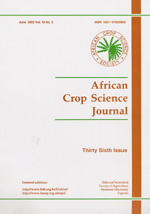
|
African Crop Science Journal
African Crop Science Society
ISSN: 1021-9730
EISSN: 1021-9730
Vol. 7, No. 1, 1999, pp. 21-33
|
 Bioline Code: cs99003
Bioline Code: cs99003
Full paper language: English
Document type: Research Article
Document available free of charge
|
|
|
African Crop Science Journal, Vol. 7, No. 1, 1999, pp. 21-33
| fr |
Okogbenin, E.; Eknayake, I.J. & Porto, M.C.M.
Résumé
Les facteurs climatiques et édaphiques sont des
composantes importantes déterminant le potentiel de
croissance et de rendement dans un environnement écologique
donné. Entre autres pratiques culturales, les
méthodes de plantation jouent un rôle, on ne peut plus
vital, dans la performance d' une culture. Les effets des
méthodes de plantation et de l' humidité du sol sur la
performance du manioc (Manihot esculenta) ont
été évalués en plein champ dans la
ferme de l ' Institut
international d' agriculture tropicale (IITA) à
Minjibir dans l' État de Kano, en zone de savane
soudanienne. Six méthodes de plantation, en condition de
monoculture, ont été évaluées pendant
deux campagnes culturales: plantation horizontale en sillons ou en
billons, plantation inclinée sur le plat ou en billons et
plantation verticale sur le plat ou en billons. Deux
génotypes ont été comparés: TMS 91934,
un clone amélioré de l' IITA et Dakata Uwariya, un cultivar
local. En ce qui concerne la hauteur du plant et la teneur en
matières sèches des tubercules, Dakata Uwariya s' est avéré
significativement meilleur (P<0,05) que TMS 91934; par contre,
TMS 91934 a présenté une meilleure formation et
rétention foliaires. Les méthodes de plantation en
billons ont positivement influencé le rendement en
tubercules et la formation foliaire, tandis que les méthodes
de plantation sur le plat ou en sillons se sont
révélées avantageuses en termes de nombre de
plants à la récolte. En général, les
méthodes de plantation inclinée se sont
avérées les meilleures. Les résultats ont
indiqué que la performance du manioc dans la zone de savane
soudanienne du Nigéria a été influencée
par le génotype, les méthodes de plantation et l' humidité du sol. Un
développement durable du manioc dans la zone
agroécologique semi-aride repose essentiellement à la
fois sur l ' utilisation de
clones dotés d ' une
bonne adaptation à la sécheresse et sur le recours
aux pratiques culturales efficaces en vue de l'obtention
d'une bonne croissance et de rendements
élevés.
Mots Clés
Formation foliaire, rétention foliaire, Manihot esculenta, méthodes de plantation, matière sèche des tubercules, rendement en tubercules
|
| |
| en |
Effect Of Planting Methods And Soil Moisture On Cassava Performance In The Semi-Arid Sudan Savanna Belt Of Nigeria
Okogbenin, E.; Eknayake, I.J. & Porto, M.C.M.
Abstract
Climatic and edaphic factors are important determinants of
the growth and yield potential of an ecological environment. Among
other cultural practices, planting methods play a very vital role
in the performance of a crop. The effects of planting methods and
soil moisture on cassava (Manihot esculenta) performance in
the Sudan savanna region of Nigeria were assessed under field
conditions at the International Institute of Tropical Agriculture
(IITA) in Minjibir, Kano State. Six planting methods in monoculture
were evaluated in two crop seasons. These were horizontal planting
on furrow or ridge, inclined planting on flat or ridge, and
vertical planting on flat or ridge.Two genotypes were compared: TMS
91934, an improved IITA clone; and Dakata Uwariya, a land race.
Dakata Uwariya was significantly better (P < 0.05) than TMS
91934 in plant height and root dry matter content; TMS 91934 was
better in leaf formation and leaf retention. Ridge-based methods
positively influenced root yield production and leaf formation,
while flat or furrow methods were advantageous in number of plants
at harvest. Horizontal and inclined planting were the best methods
in general. Results showed that cassava performance in the Sudan
savanna of Nigeria was influenced by genotype, planting methods and
soil moisture. Sustainable development of cassava in the semi-arid
agroecology essentially depends on the use of clones with good
drought adaptation, combined with efficient cultural practices for
good growth and yield.
Keywords
Leaf formation, leaf retention, Manihot esculenta, planting methods, root dry matter, root yield
|
| |
© Copyright 1999 - African Crop Science Society
|
|